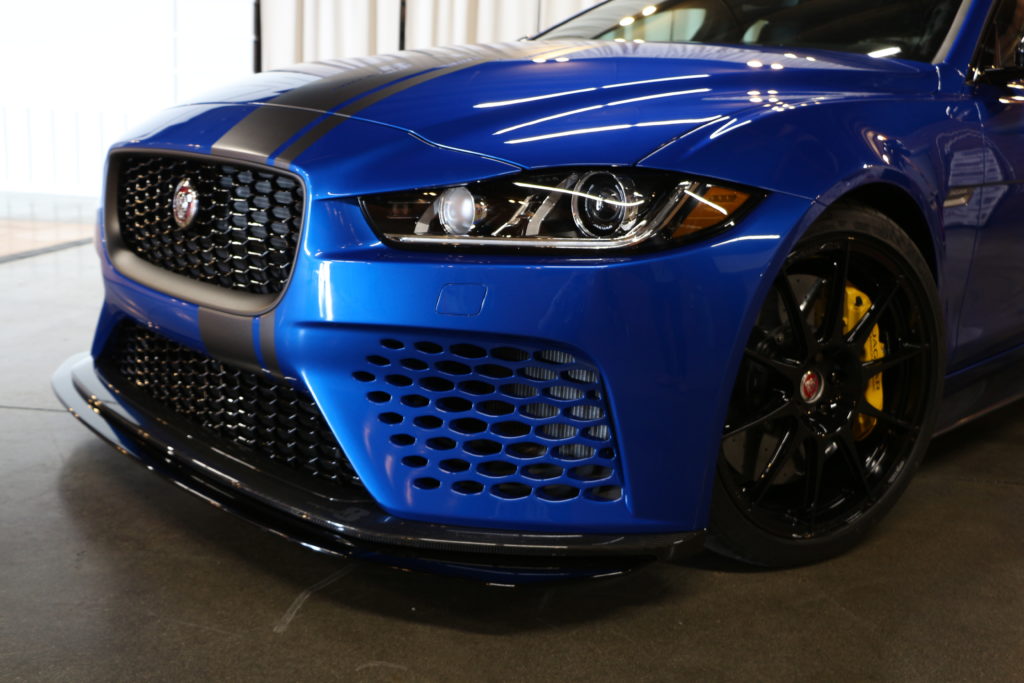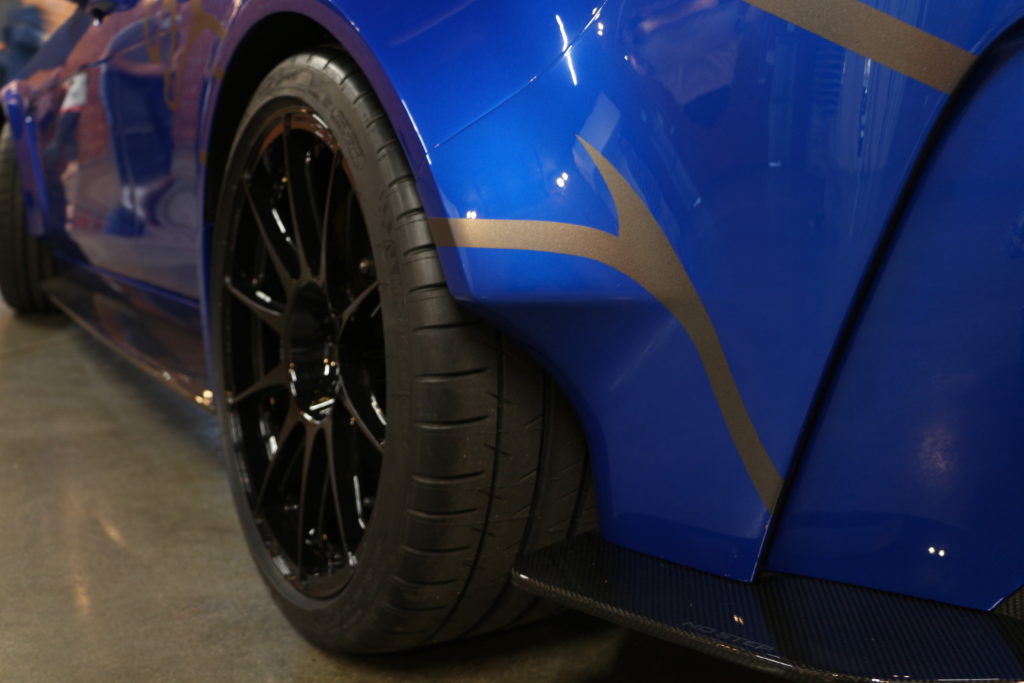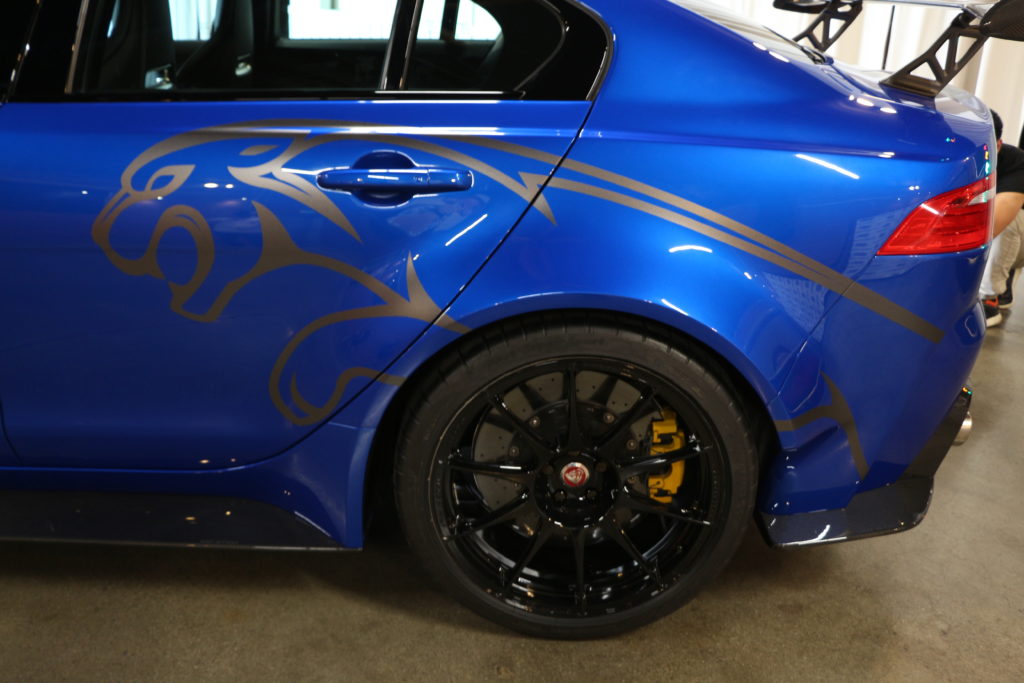Jaguar XE SV Project 8 and Our Q&A with Jaguar SVO
Jaguar XE SV Project 8 is the British ‘shock and awe’ we’ve always dreamed of.
The term “shock and awe,” as defined by Encyclopedia.com, is “A military strategy based on achieving rapid dominance over an adversary by the initial imposition of overwhelming force and firepower.” We can’t think of a better way to describe the impact made by the Jaguar XE SV Project 8 than that. This 200 mile per hour super sedan absolutely trounces the competition — if you can even call it competition. With 592 horsepower on tap, it easily outdoes the 493 hp BMW M4 GTS or 503 hp Mercedes-Benz AMG C63 S. However, there is so much more to the XE super-sedan than that. In fact, the power figure pales in comparison to all of the changes Jaguar’s Special Vehicle Operations (SVO) team made to the XE.
Naturally, we squealed with delight like small children when Jaguar rang up Jaguar Forums and asked if we were interested in seeing the new XE SV Project 8 in person. After regaining our composure, we said that would be great.
A few days later, the Project 8 announced its arrival with much fanfare. With looks that kill and a noise that nearly did, here is what happened during our afternoon with the Jaguar XE SV Project 8.
One minor sticking point with Project 8: It’s not yet road legal.
There are currently two Jaguar XE SV Project 8s in existence: the orange car that ran Goodwood, and this one. These cars have been put through the ringer as 99% complete test mules. However, they are not road legal, yet. As such, our Project 8 sampler arrived via enclosed trailer. Of course, this took away from exactly 0% of the fanfare surrounding the car, because we got to experience the Project 8 explode into existence when it cold-started inside the trailer. It’s so angry.
After some careful maneuvering, and managing to avoid snagging the extended front splitter on the ramps, Project 8 was free to roam. Or, at least, free to roam about 30 feet from the trailer to inside the building. Once situated inside, the poking and prodding commenced, with much “oohing” and “aahing” from us all. The black art of aerodynamics is heavily in play with the Jaguar XE SV Project 8, that much is obvious.
As we poured over the details, and collectively lost our minds over how insane and aggressive the Project 8 is in person, a few people quietly walked in behind the car. Dan Connell, Head of Global PR and Marketing for Jaguar Land Rover SVO, and Dave Foster, SVO Advanced Product Creation Manager (aka Lead Engineer for Project 8), to be specific. These two gents were very good sports and agreed to answer our questions, and yours. Before cracking on, we vetted a few questions and asked what was on and off limits, and the answer was surprisingly very little of the latter. Excellent. You can watch the video at the top of this post for the full interview and hear the answers to your questions.
Let’s talk aerodynamics…
Aerodynamics is the science of understanding the movement of air. In the context of cars, the term aero is used specifically in the context of controlling the air around the car and bending it to the driver’s will to optimize performance. Effective use of aerodynamics improves cooling by moving more air through your various radiators, heat exchangers and coolers, and not allowing said air to get trapped in hot, contained areas like the engine bay. Effective aero is also crucial in terms of high-speed cornering and stability. However, in the context of a 200 mph super sedan, the goal is to optimize the downforce-to-drag ratio, making a car that offers both excellent high speed stability and top speed capability.
Today, we are going to focus on the aerodynamic elements of Project 8.
So many aerodynamic details to examine, starting with the front.
Let’s start from the front and work our way back. The front bumper is obviously all-new, from the ground up. Made of carbon fiber, the contours, and air inlets are all the result of a lot of computer modeling and computation fluid dynamics (CFD). There are two elements to the lower splitter. The first piece is a carbon fiber air dam attached directly the bumper cover, from there, a second piece made from composite fiber-reinforced plastic is attached. This lower splitter is adjustable, able to be moved in or out by approximately 2 inches, and is designed to be less costly to replace versus the carbon fiber piece atop it, should a bump or scrape happen.
Situated on either side of the bumper are charge air coolers for the supercharger. The cutouts in the bumper are designed to improve airflow through those coolers, that they look wicked is purely coincidental. The “fangs” beside these openings are functional air channels, directing air through the wheel arches, where air tends to get trapped without aerodynamic “help” (more on this later).
The hood (bonnet) is also carbon fiber, as you can see from the heat extractor in the center, which was left in bare carbon. The rear of the hood and cowl line area is completely sealed to reduce air getting trapped. In order to extricate excess heat, and improve the inherent high pressure air zone, the hood was vented in the area most likely to trap turbulent, hot air.
Working our way to the side of the car, the aero tweaks continue…
The front end of the Project 8 is full of complex shapes, tweaks and menace. Comparatively, in profile less seems to have changed. That is, until you start looking more closely. The headlights have been pushed forward nearly an inch. All the better to facilitate fitting the supercharged V8 under that bonnet and into the engine bay. Remember how we mentioned that air likes to get trapped in those widened wheel wells? Obviously, that is detrimental to aerodynamic efficiency, as well as tire and brake cooling. So, in addition to the front bumper pushing air through, the front fenders have their rear lower sections cut away. This leads airflow down the massively widened carbon fiber side sills.
Those widened sills roll into the massively widened quarter panels. This is the most thorough redesign of the entire car. 2.2 inches wider on each side, the entire unibody had to be redesigned to implement this. Also, note that in order to optimize the car’s side profile aerodynamics, the rear doors were also redesigned and widened to better flow into the modified arches. The 3/4 view of Project 8 is absolutely jaw dropping. The widened hips and big rubber give this car such an aggressive stance. Taking it all in, the Jaguar XE SV Project 8 looks like it could be a GT car running in the Pirelli World Challenge, bolt on some slicks and go.
Finally, we follow the airflow as it’s channeled to the rear end.
That wing, wow. Made from carbon fiber, with aluminum uprights, it’s a thing of beauty. Oh, and those uprights have two angles of attack and have strategically designed cutaways to optimize air flow and minimize both drag and weight. Though, the racer in me wonders what the Project 8 would look like with a “swan neck” style wing, that is in vogue these days.
Of course, there’s more going on back there than just the wing. Peak up the Project 8’s skirt to reveal more aero and more carbon fiber. The rear diffuser wraps around the exhaust and rear bumper, minimizing the chance for air to get trapped back there. Note the extrication holes in the diffuser to allow air to pass through (pictured below).
The differential and rear driveline and subframe are similar to that of a regular XE, though it is now solidly mounted versus using rubber bushings, to minimize rear end deflection, and undue dynamic alignment changes under cornering. I am a big fan of this, having swapped solid subframe “bushings” into previous project cars of my own. This makes the rear end much more planted and communicative, allowing for a better connection to what the rear tires are doing. That’s quite useful when you have 592 horsepower on tap and are trying to exit a corner with maximum urgency.
While the rear driveline is similar to a regular XE, the rear floor pan and structure of the car modified to bring everything up, and the rear suspension was modified for clearance. “Clearance for what,” you may be asking, the carbon fiber and composite flat floor, of course. The air traveling under the car is, in many cases, more important than the air traveling above it. Let the record show that this particular car does not have the rear differential cooler that the final production vehicle will have. Need to be able to cool the variable-lock up, electronically-controlled, limited-slip differential, of course.
But wait, there’s more!
So much more, in fact. Really, we have only scratched the surface. That’s just an overview of the extensive changes Jaguar’s SVO team made to the XE body to create Project 8. We haven’t talked about the bespoke suspension components, wheels and plethora of other goodies we learned about after prodding the SVO boys with questions.
Stay tuned…
During our afternoon with the Jaguar XE SV Project 8 we learned a lot about the car, and about Jaguar SVO. In fact, we learned so much that it can’t reasonably fit in one article. So, stay tuned, because next up, we have a few top secret tidbits about Project 8 that have yet to be reported by any other publication.

































